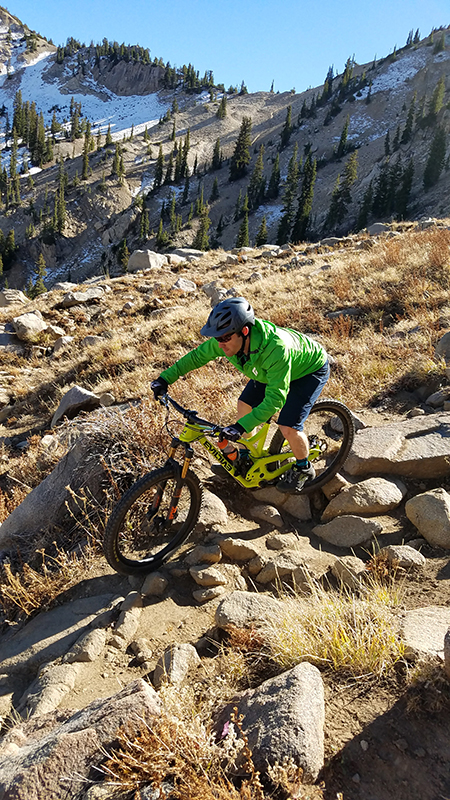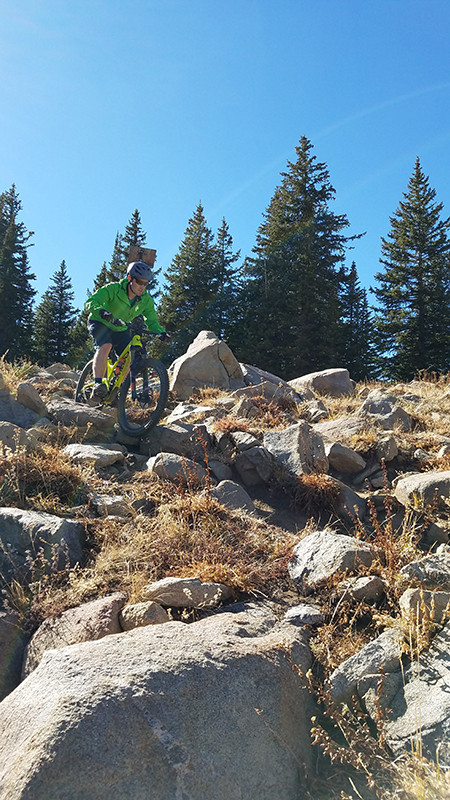
2017 Fox 36 RC2 Float Fork
Travel: 160 mm
Offset: 44 mm
Axle to Crown: 549 mm
Blister’s Measured Weight: 2,003 g (4.42 lbs)
Stated Weight: 4.38 lbs
MSRP: $1,049
Reviewer: 5’8”, 160 lbs.
Test Location: Park City, UT
Days Tested: 30 rides
Intro
Back in 2013, RockShox and Fox were competing for 160mm-travel, single-crown dominance with the Lyrik and the 36, respectively. Then in 2014, Rock Shox changed the game when they decided that they were going to support 27.5” wheels in a big way and released their revised Pike fork to accommodate riders looking for a 160 mm travel option in that wheel size.
The Rock Shox Pike was a hit because of its supple action and low weight. I remember when I first rode one; I was worried about it being less stiff than my old Lyrik, especially because they had forgone the 20 mm axle of the previous Pike and Lyrik for a 15 mm axle. But I wanted a 27.5” wheeled bike, and there was no real choice at the time but to get a Pike. Plus it exhibited class-leading suppleness. It was good. I enjoyed the performance and forgot about my stiffness concerns … until stiffer options became available in the form of the Fox 36 and the RockShox Lyrik/Yari.
Now that I’ve ridden both, I’ve gotta say, the increased steering precision is worth the weight gain. I’m committed to these stiffer forks for 150 mm of travel or more. I’ve spent a lot of time on the RockShox Pike and Yari, but until recently, only very little time on the new Fox 36.

The Fox 36 interested me for a few reasons. First, while I have had some great experiences with RockShox forks, they have limited compression adjustments. The 36 has high- and low-speed compression adjustments.
Second, the last couple times I had the opportunity to try the Fox forks, it was clear that they’ve worked quite a lot on their air springs and seal to compete with RockShox on suppleness. Fox has even added an air spring volume adjustment spacer system similar to RockShox.
Third, I was excited to take advantage of the 36’s axle options and a / b test the 15 mm and 20 mm axles. The noise around the move from 20 mm to 15 mm axles on single crown forks has quieted down some, but I still wonder how big the impact of the change really has.
Options
Fox offers a ton of configuration options for the 36:
Air Spring:
- FLOAT
- TALAS (adjustable travel)
Wheel size:
- 26″
- 27.5″
- 29″
- 26″ 831 (100 mm dirt jump fork)
- 27.5″ Pedelec (e-bike fork)
- Axle configuration: 15×100 mm, 20×110 mm, 15×110 mm (Boost)
Travel:
- 26” – 160, 180 mm
- 27.5” – 130/160 mm, 140, 150, 160, 170 mm
- 29” – 130/160 mm, 150, 160mm
Damper:
- FIT4
- FIT HSC/LSC
Offset:
- 26”, 36 mm
- 27.5”, 44 mm
- 29”, 51 mm
In the 27.5” configuration, a RockShox Pike features 42 mm offset. By all accounts, the Fox 36 with its 44 mm offset should handle just a bit more quickly. But I didn’t really notice the offset difference.
Chassis
I have been spending time on the Fox 36 with the full bolt through axle option: a bolted axle that threads into the left fork leg and two pinch bolts on each leg. There is no question in my mind that the full bolted design makes the fork stiffer. It is significantly stiffer than the Yari, which uses Rockshox’ Maxle Ultimate. I’ve tried the 36 both with the bolt-through axle in its 20 mm form and adapted down to 15 mm form. Both are stiffer than the Yari and I don’t imagine the chassis design differences are enough to account for the difference in stiffness. I do think the 20 mm option is stiffer, but the difference wasn’t big enough to slap me in the face. I’m more convinced that the biggest difference is in the clamp style.
Yes, removing the wheel from the 36 fork is time-consuming and requires an allen tool. It is unquestionably slower than wheel removal with a Maxle system, but I have bike racks that allow me to leave a wheel on my bike, so I’m really only removing the wheel when I need to change a tire. The stiffness increase is big enough that I think the inconvenience is worth it.

Why does the axle design matter? Well, having the axle clamped on both sides does a lot to reduce twisting motion. It prevents any motion of the legs along the axle. Without such a design, the legs can move more easily relative to each other, making the torsional stiffness seem lower. The high torsional stiffness of the 36 makes steering feel quicker in most situations and helps me to hold a line through rough terrain.
I quite like that Fox has made all the axle clamp and axle screws replaceable hardware. So, if you really bugger it up and strip any threads out, you can just order a small replacement piece instead of needing to order new lowers.
The arch on the 36 leaves more vertical clearance around the tire than either the RockShox Pike or the RockShox Lyrik. I’d also say that there is a bit more clearance on either side of the tire than with the RockShox options. The difference isn’t huge, but it is present.
The compression knobs are nice and low profile, but still easy to adjust with enough grippiness for somewhat muddy fingers.
One uniquely Fox feature is the cover for the rebound knob. It is a bit obnoxious to take on and off, but it does protect the knob and you could always leave it off if it bothers you a lot.
Air Spring
Fox has worked hard to improve their air spring. It is a more complex-looking system than RockShox uses, but I found it to offer good tunability and suppleness.
It uses positive and negative air springs. Volume can be readily adjusted with plastic spacers. They come in a small and a large size and you can use up to 4 of them. They are slightly harder to install than the RockShox equivalent, but certainly still easily installed.
The travel can readily be changed with an inexpensive spacer and an adjustment to the air shaft length. It does require pulling the lowers off the fork and Fox provides a nice instructional video. It is pretty great to be able to make a travel change without needing to buy a different air shaft as one has to with a Pike.
NEXT: Damping, Comparisons, Etc

Some useful insights here, particularly on air-volume tuning & bottoming. I spent a day demoing a new bike w/ a Fox 36 and was thoroughly underwhelmed by its lack of responsiveness, so your findings on the break-in period are also helpful beta.
There is a major flaw, however, in your “comparison” approach: without direct A/B comparison where you put as much work into fine-tuning a charger-dampened Lyrik as you did the 36, the your conclusions don’t mean much.
The Pike competes w/ the 34, we know it’s lighter & flexier. The Yari is the econo-version of the Lyrik, so it is to be expected that paying $300 more for a 36 gets you more sophisticated tuning options.
Give this article an update after you’ve spent equal time on a Lyrik, and you’ll have yourself a proper, Blister-quality review!
Matt, eager to get some significant time in on a Lyrik, just haven’t been able to make it happen yet.